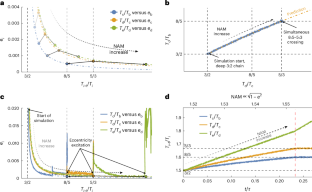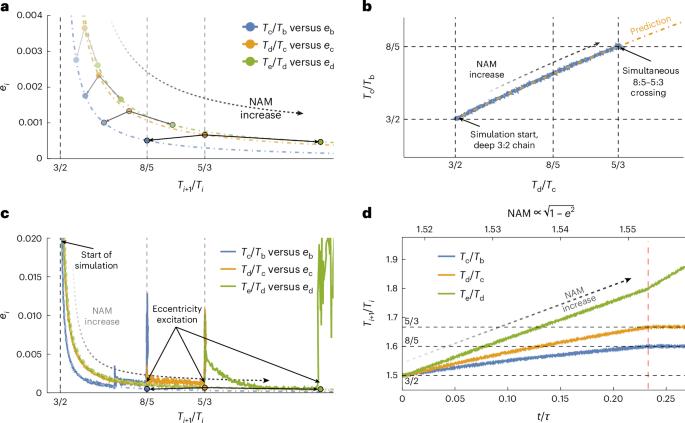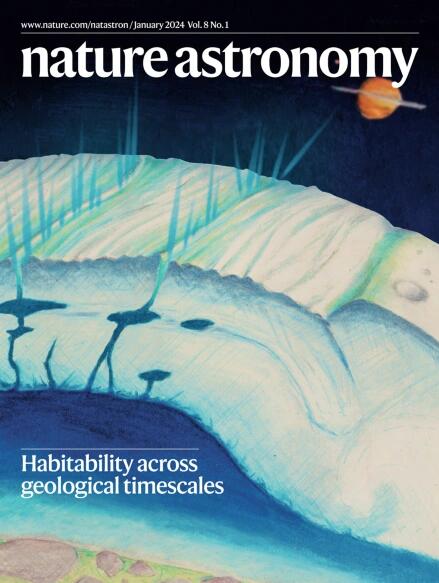TRAPPIST-1系统在星盘内缘后退过程中分两步形成
IF 14.3
1区 物理与天体物理
Q1 ASTRONOMY & ASTROPHYSICS
引用次数: 0
摘要
TRAPPIST-1 有七颗行星。相邻行星对的周期比接近于 8:5、5:3、3:2、3:2、4:3 和 3:2,随着与恒星距离的增加而增加。据观测,与相邻三胞胎相关的拉普拉斯角是平移的,这证明了该系统的共振性质。这种紧凑的共振构造是磁盘驱动迁移的明显标志;然而,这种演化的首选结果是建立一阶共振,而不是在内部系统中观测到的高阶共振。在这里,我们用一个与具体的磁盘迁移和轨道圆化效率基本无关的模型来解释观测到的轨道构型。除了迁移之外,我们的模型还有两个关键要素,一是原行星盘的内部边界随着时间的推移而后退,二是该系统最初被分离成两个子系统。具体来说,内侧的b、c、d和e行星最初处于3:2共振链中,后来由于盘内侧边缘的后退,b、c和d行星之间的共振演化为8:5-5:3共振,而外侧行星则在后来迁移到盘内侧边缘,并建立了剩余的共振。我们的研究结果集中体现了目前无法观测到的原行星盘内缘后退的动力学作用。这些结果还揭示了当共振链与迁移障碍相互作用时,先是会聚迁移,然后是共振排斥以及相关的轨道环化等反复出现的阶段的作用。本文章由计算机程序翻译,如有差异,请以英文原文为准。


The formation of the TRAPPIST-1 system in two steps during the recession of the disk inner edge
TRAPPIST-1 hosts seven planets. The period ratios of neighbouring pairs are close to the 8:5, 5:3, 3:2, 3:2, 4:3 and 3:2 ratios in increasing distance from the star. The Laplace angles associated with neighbouring triplets are observed to be librating, proving the resonant nature of the system. This compact, resonant configuration is a manifest sign of disk-driven migration; however, the preferred outcome of such evolution is the establishment of first-order resonances, not the high-order resonances observed in the inner system. Here, we explain the observed orbital configuration with a model that is largely independent of the specific disk migration and orbital circularization efficiencies. Together with migration, the two key elements of our model are that the inner border of the protoplanetary disk receded with time and that the system was initially separated into two subsystems. Specifically, the inner b, c, d and e planets were initially placed in a 3:2 resonance chain and then evolved to the 8:5–5:3 commensurability between planets b, c and d due to the recession of the inner edge of the disk, whereas the outer planets migrated to the inner edge at a later time and established the remaining resonances. Our results pivot on the dynamical role of the presently unobservable recession of the inner edge of protoplanetary disks. They also reveal the role of recurring phases of convergent migration followed by resonant repulsion with associated orbital circularization when resonant chains interact with migration barriers. The dynamical history of the seven-planet TRAPPIST-1 system, which is marked by delicate orbital resonances, is meticulously reconstructed. This study unveils the key physical processes that shaped its formation during and beyond the circumstellar disk phase.
求助全文
通过发布文献求助,成功后即可免费获取论文全文。
去求助
来源期刊

Nature Astronomy
Physics and Astronomy-Astronomy and Astrophysics
CiteScore
19.50
自引率
2.80%
发文量
252
期刊介绍:
Nature Astronomy, the oldest science, has played a significant role in the history of Nature. Throughout the years, pioneering discoveries such as the first quasar, exoplanet, and understanding of spiral nebulae have been reported in the journal. With the introduction of Nature Astronomy, the field now receives expanded coverage, welcoming research in astronomy, astrophysics, and planetary science. The primary objective is to encourage closer collaboration among researchers in these related areas.
Similar to other journals under the Nature brand, Nature Astronomy boasts a devoted team of professional editors, ensuring fairness and rigorous peer-review processes. The journal maintains high standards in copy-editing and production, ensuring timely publication and editorial independence.
In addition to original research, Nature Astronomy publishes a wide range of content, including Comments, Reviews, News and Views, Features, and Correspondence. This diverse collection covers various disciplines within astronomy and includes contributions from a diverse range of voices.
 求助内容:
求助内容: 应助结果提醒方式:
应助结果提醒方式:


